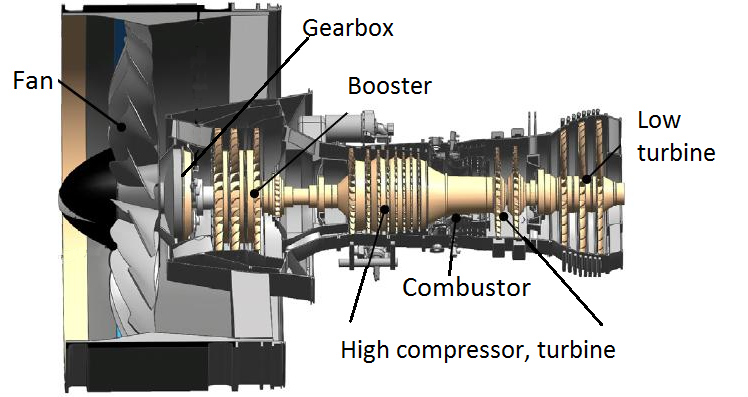Leeham News and Analysis
There's more to real news than a news release.
Rolls-Royce sets out ambitious vision to future-proof its business
Subscription Required
By Gordon Smith
 November 29, 2023, © Leeham News: Rolls-Royce’s (RR) capital markets day presented a business that has bookended 2023 with two very different narratives. The November 28 event heralded targets such as a quadrupling of operating profit within five years, delivered via a bullish new growth strategy and re-energized vision for the future. How different things felt just 11 months earlier.
November 29, 2023, © Leeham News: Rolls-Royce’s (RR) capital markets day presented a business that has bookended 2023 with two very different narratives. The November 28 event heralded targets such as a quadrupling of operating profit within five years, delivered via a bullish new growth strategy and re-energized vision for the future. How different things felt just 11 months earlier.
In January, new chief executive Tufan Erginbilgic adopted something of a shock-and awe approach, describing the company’s position in terms so blunt that it made even the most experienced market watchers blush.
Picking up the baton from Warren East – who had led the business for eight years – Erginbilgic’s comments went beyond the conventional candor of an incoming exec and spooked many. The new boss labeled the British firm a “burning platform” and described Rolls’ status quo as “unsustainable”.
Despite efficiency drives instigated by his predecessor, Erginbilgic’s message was clear; 2023 represented a “last chance” to change. Needless to say, there was a particularly high degree of expectation behind Rolls’ flagship investor event, his first as CEO.
Pontifications: Airbus ponders A330neo MRTT, Boeing ponders KC-46A re-engine
By Scott Hamilton
Nov. 28, 2023, © Leeham News: In a reversal of intent, the airplane that Airbus may submit to the US Air Force for the next round of aerial tanker procurement may be based on the A330neo instead of the current production A330-200ceo MRTT.
The Air Force, however, may forego competition between Airbus and Boeing and place a sole-source follow-on order with Boeing for the KC-46A tanker, based on the 767-200ER. Boeing already has a contract for 179 KC-46As, and the USAF appears to be leaning toward a sole-source award. Political pressure from Airbus partisans and others who favor competition may prevail.
Related articles
- Airbus to develop second generation MRTT based on A330neo. (Aviation Week.)
- Lockheed Martin sees MRTT as complimentary to KC-46A
- Lockheed bows out, Airbus to continue, Boeing favored in tanker procurement
Airbus wants to discontinue production of the A330-200ceo-based MRTT. The neo-based version would be based on the A330-800. Sales of the -800 are poor—fewer than 20 have been ordered. An -800 based MRTT will breathe life into the nearly still-born model.
- Boeing considers re-engining the 767-300ERF and the KC-46A.
- KC-46A, 767-200, A330 MRTT exempt from 2027 ICAO standards.
Preview of Rolls-Royce Capital Markets Day
Subscription Required
By Scott Hamilton
 Nov. 27, 2023, © Leeham News: Rolls-Royce’s Capital Market Day is tomorrow. “Our multi-year transformation programme will deliver a high-performing, competitive, resilient, and growing business. Join us to find out how we are going to do it and what a stronger Rolls-Royce will mean for all our stakeholders,” the company says on its website.
Nov. 27, 2023, © Leeham News: Rolls-Royce’s Capital Market Day is tomorrow. “Our multi-year transformation programme will deliver a high-performing, competitive, resilient, and growing business. Join us to find out how we are going to do it and what a stronger Rolls-Royce will mean for all our stakeholders,” the company says on its website.
“Our multi-year transformation programme has started well with progress already evident in our strong initial results and increased full-year guidance for 2023. There is much more to do to deliver better performance and to transform Rolls-Royce into a high-performing, competitive, resilient, and growing business. We will share the outcome of our strategy review along with medium-term goals for the Group in November,” said CEO Tufan Erginbilgic on its website.
It has some other questions to answer, too.
An order for Airbus A350-1000s was expected to be announced at the Dubai Air Show by Emirates Airline. Another order, for a combination of A350-900s, -1000s, and A320neo, was expected from Turkish Airlines. Neither materialized—and, LNA is told, issues with the Trent XWB 97 were one reason.
Pontifications: “We’re sick and tired of new technologies:” Avolon CEO
Editor’s Note: As Airbus and Boeing consider new airplanes, their current generation aircraft are plagued with technical issues. The engines on the A320neo and 737 MAX families continue to have problems years after entry into service. The Boeing 787, which had ground-breaking technology when it was designed, has production issues. Flight testing early on revealed technical problems with the engine on the 777X, prompting the president of Emirates Airline to publicly suggest he won’t accept delivery until the engines are fully “mature.”
Aviation Week’s Check 6 podcast last week examined Boeing’s path toward a new airplane. Boeing CEO David Calhoun insists on waiting for new technology. But “new technology,” while in theory is a great idea, the phrase also scares people. LNA reported on this in March 2020. We’re reposting this article from then.
Related Stories
Now Open to All Readers
Subscription Required
Introduction
By Scott Hamilton
March 16, 2020, © Leeham News: “I can tell you from our perspective, we’re kind of sick and tired of new, new technology. It’s not proven to be the home run.”
This blunt assessment comes from the chief executive officer of the big aircraft lessor, Avolon.
Domhnal Slattery, the CEO, was giving his critique of whether Boeing should launch a new airplane once the 737 MAX crisis is over. (Update: Since this interview, Slattery retired from Avolon.)
Boeing was on a path to decide whether to launch the New Midmarket Airplane when the MAX was grounded one year ago this month.
Airbus was waiting for Boeing to move before deciding how to respond.
Summary
- Airbus and Boeing should “stick to their knitting.”
- Focus on incremental improvements for now.
- 2030s to 2050s will be the next big advance in technologies.
United selects GEnx for order for 100 787s
Subscription Required
By Scott Hamilton
Aug. 14, 2023, © Leeham News: United Airlines quietly selected GE engines for its order in December last year for 100 Boeing 787-9s, according to Boeing’s website. The order isn’t finalized and neither GE nor United would comment.
There had been speculation that UAL might order Rolls-Royce engines as a mitigation for cancelling 45 Airbus A350-900s, which is powered exclusively by RR. United repeatedly deferred delivery of the A350s, which were ordered by previous managements. United inherited a large order for 787s when it merged with Continental Airlines and placed repeat orders for the 787 after the merger. The A350s essentially are duplicative to the 787s.
United placed large orders for the Airbus A321neo at a time when Boeing at first dithered whether to launch the New Midmarket Aircraft. UAL added to the neo order during the time when Boeing was unable to pursue any new airplane program due to the extended grounding of the MAX and during the COVID pandemic.
Pontifications: Engine makers’ business model needs overhaul
May 2, 2023, © Leeham News: The business models for engine makers for decades have been simple: deeply, deeply discount the engines on the sale and make up the revenue and profits on the maintenance, overhaul, and repair (MRO) contracts.
It’s a model that’s served engine makers and customers alike well. Customers save millions of dollars on the upfront purchase of airplanes. The engine companies win market share.
There are downsides for the Original Equipment Manufacturers (OEMs), though. The discounts typically are steeper than those offered by Airbus and Boeing (and Embraer and ATR). LNA has seen deals with discounts as steep as 80% on the sales price. We’ve even seen one deal in which the OEM gave (as in free) the engines in exchange for the MRO contract.
The big downside to this is that it can take 10-12 years, or more, for the OEMs to recover their research and development and production ramp/learning curve costs. Then as the CFM 56 matured into perhaps the most reliable jet engine ever, with more than 25,000 hours on-wing, followed by the IAE V2500, MRO services contracts didn’t return the revenue and profits as quickly as before.
Bjorn’s Corner: New aircraft technologies. Part 9. Engine core advances
April 21, 2023, ©. Leeham News: This is a summary of the article New aircraft technologies. Part 9P. Engine core advances. The article discusses how developments for the next-generation airliner engine cores will increase the thermal efficiency of next-generation engines.
Bjorn’s Corner: New aircraft technologies. Part 9P. Engine core advances
Subscription required
By Bjorn Fehrm
April 21, 2023, ©. Leeham News: This is a complementary article to Part 9. Engine core advances. It discusses in detail the next-generation propulsion system cores and what efficiency improvements to expect from different technological advancements.





